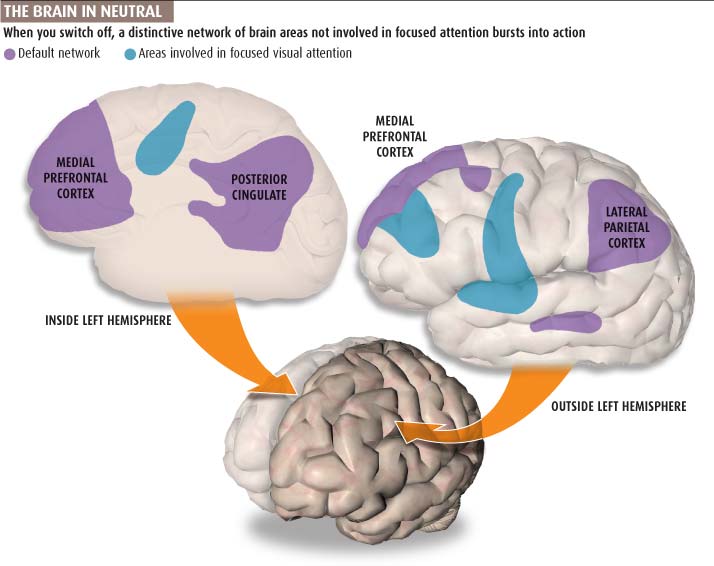[aesop_image img=”https://hilite.org/core/wp-content/uploads/2014/05/default-net.jpg” caption=”DELANCEYPLACE.COM / SOURCE” align=”left” captionposition=”left” lightbox=”off”]Daydreaming – an activity in which virtually everyone engages at some point in their lives. For some, daydreaming is an activity in which we can envision possible scenarios, work out problems, or create entirely new ideas. For others, it can become something of an addiction, in which we picture ourselves in idealized lives and scenarios, thus becoming cut off from the real world.
At the beginning of 2014, scientists discovered something in the brain – a certain matrix, if you will – which has now come to be known as the “default network” and which plays a major role in daydreaming. When our brain is unoccupied with focused tasks, the default network switches on, and we enter the world of our daydreams.
The default network is very important for things beyond imagined scenarios. It also plays a crucial role in self-identification; it is possible, in light of this fact, that daydreaming plays a key role in determining who we are as people.
Daydreaming, it seems, may actually be a much more active, involved process than most would think. It involves not only the default network, but also the “executive network” (the brain’s “control center”). This means it can have benefits that go beyond the simple formulation of ideas, including memory retrieval, enhanced creative problem solving and the derivation of meaning from past experiences. However, it can turn unproductive.
What can happen is that people, often but not exclusively when confronted with seemingly inescapable realities, will retreat back into their minds as a means of escape. The line between productive and maladaptive daydreaming, however, is somewhat hazy. The general consensus among psychologists and cognitive scientists is that if it causes interference in everyday life, it is excessive. As long as the daydreamer is able to maintain balance it shouldn’t be of any concern.
To share something of my own here, I decided to explore this topic primarily because of my interest in the mind, but also because I frequently notice myself daydreaming. Earlier during the writing process I caught myself interacting with Aldo Nephron, an artist’s sketch who wants desperately to be a human being (if you’re interested, this happened somewhere around the second paragraph). As I see it, I’m not daydreaming past the point of excess, but I do have a tendency to get a bit…lost. And I must say, I understand very well how daydreaming could become a very serious problem for someone. Spending much more time enveloped in fantasy would certainly endanger my productivity.
Just a minor personal note I thought might add something there. Anyways, that’s all I have for this week. Until the next time, for science!


































![British royalty are American celebrities [opinion]](https://hilite.org/wp-content/uploads/2024/03/Screenshot-2024-03-24-1.44.57-PM.png)



















![Chelsea Meng on her instagram-run bracelet shop [Biz Buzz]](https://hilite.org/wp-content/uploads/2024/04/IMG_2446-1200x838.jpg)
![Review: Quiet on Set: The Dark Side of Kids TV is the long awaited exposé of pedophilia within the children’s entertainment industry [MUSE]](https://hilite.org/wp-content/uploads/2024/04/unnamed.jpg)
![Review: “The Iron Claw” cannot get enough praise [MUSE]](https://hilite.org/wp-content/uploads/2024/04/unnamed.png)
![Review: “The Bear” sets an unbelievably high bar for future comedy shows [MUSE]](https://hilite.org/wp-content/uploads/2024/03/unnamed.png)
![Review: “Mysterious Lotus Casebook” is an amazing historical Chinese drama [MUSE]](https://hilite.org/wp-content/uploads/2024/03/0.webp)
![Review in Print: Maripaz Villar brings a delightfully unique style to the world of WEBTOON [MUSE]](https://hilite.org/wp-content/uploads/2023/12/maripazcover-1200x960.jpg)
![Review: “The Sword of Kaigen” is a masterpiece [MUSE]](https://hilite.org/wp-content/uploads/2023/11/Screenshot-2023-11-26-201051.png)
![Review: Gateron Oil Kings, great linear switches, okay price [MUSE]](https://hilite.org/wp-content/uploads/2023/11/Screenshot-2023-11-26-200553.png)
![Review: “A Haunting in Venice” is a significant improvement from other Agatha Christie adaptations [MUSE]](https://hilite.org/wp-content/uploads/2023/11/e7ee2938a6d422669771bce6d8088521.jpg)
![Review: A Thanksgiving story from elementary school, still just as interesting [MUSE]](https://hilite.org/wp-content/uploads/2023/11/Screenshot-2023-11-26-195514-987x1200.png)
![Review: When I Fly Towards You, cute, uplifting youth drama [MUSE]](https://hilite.org/wp-content/uploads/2023/09/When-I-Fly-Towards-You-Chinese-drama.png)
![Postcards from Muse: Hawaii Travel Diary [MUSE]](https://hilite.org/wp-content/uploads/2023/09/My-project-1-1200x1200.jpg)
![Review: Ladybug & Cat Noir: The Movie, departure from original show [MUSE]](https://hilite.org/wp-content/uploads/2023/09/Ladybug__Cat_Noir_-_The_Movie_poster.jpg)
![Review in Print: Hidden Love is the cute, uplifting drama everyone needs [MUSE]](https://hilite.org/wp-content/uploads/2023/09/hiddenlovecover-e1693597208225-1030x1200.png)
![Review in Print: Heartstopper is the heartwarming queer romance we all need [MUSE]](https://hilite.org/wp-content/uploads/2023/08/museheartstoppercover-1200x654.png)






















![Review: Ladybug & Cat Noir: The Movie, departure from original show [MUSE]](https://hilite.org/wp-content/uploads/2023/09/Ladybug__Cat_Noir_-_The_Movie_poster-221x300.jpg)

![Review: Next in Fashion season two survives changes, becomes a valuable pop culture artifact [MUSE]](https://hilite.org/wp-content/uploads/2023/03/Screen-Shot-2023-03-09-at-11.05.05-AM-300x214.png)
![Review: Is The Stormlight Archive worth it? [MUSE]](https://hilite.org/wp-content/uploads/2023/10/unnamed-1-184x300.png)


![Seniors Jillian Rang and Athul Ramkumar practice their presentation at the DECA state competition on March 5, 2024. Arya Patel, DECA paper head and junior, said, As they [students] begin to make their final preparations, its important to remember that making it to this point is an incredible achievement.](https://hilite.org/wp-content/uploads/2024/04/IMG_8285-1200x800.jpg)

